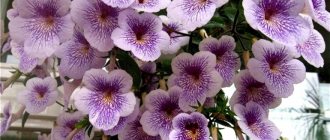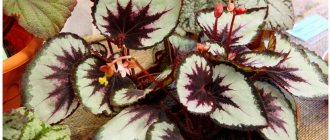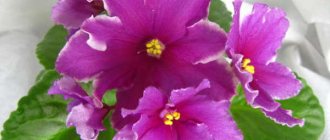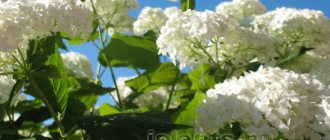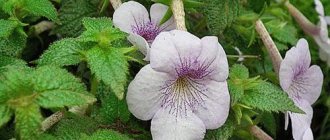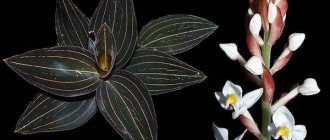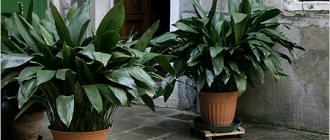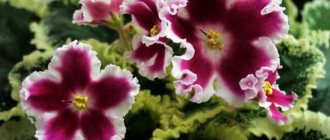Translated from ancient Greek, achimenes (genus Achimenes Pers) is translated as “afraid of the cold.” This herbaceous perennial, native to South and Central America, Jamaica, Mexico, belongs to the Gesneriev family and, along with gloxinia and violet, is considered one of its most beautiful representatives.
The crop was first brought to England from Jamaica in 1778, and quickly gained popularity during the Victorian era. Interestingly, Achimenes is also known as the “hot water plant”, since it was previously mistakenly believed that hot watering promotes abundant flowering.
Description
The main advantage of the culture is its long, magnificent, abundant flowering, which lasts from the end of May to October, which is due to the constant development of new buds.
Funnel-shaped flowers with a long tubular corolla appear from the leaf axils. Their color range is striking in its richness of colors and shades - from beige to inky purple.
Many species feature stunning double flowers, some monochromatic, others two or three colors often with a contrasting colored center. Some breeders classify Achimenes by color group: yellow, pink, purple, white.
The leaves of the plant are heart-shaped, shiny, with jagged edges; in some varieties, the leaves on the reverse side are purple or pink.
In cultivation you can find ampelous varieties with long hanging shoots and a bushy growth form. Slightly pubescent stems grow from underground rhizomes, some of them resemble small scaly pine cones, others are round or pear-shaped.
Popular indoor species and some varieties of Achimenes
There are about 40 types of culture in nature. Many of them have been widely hybridized and most hybrids are obtained from crossing the large-flowered species A. grandiflora and A. longiflora. For example, the hybrid "Purple King" combines numerous varieties with purple or blue flowers.
Purple King
We will describe these two species, which are most often grown at home. The varieties of Achimenes are so numerous that it is impossible to describe and list each of them.
Achimenes Longiflorum is native to Guatemala. Grows up to 30 cm in height. Stems and leaves are slightly pubescent. The growth form is ampelous. The flowers are large purple with a long narrow tube.
Well-known varieties obtained from hybrid forms: snow-white “Alba” and “Ambroise Verschaffelt” with purple lines along the flower, the well-known double large-flowered variety with petals of delicate yellow, cream and pink shades “Yellow English Rose”, “Major” with large blue flowers.
Achimenez Yellow-English-Rose
Achimenes grandiflora. The height of the spreading bush is from 30 to 60 cm. The stems are pubescent, vertical, green or reddish in color. The leaves are green on the outside and pale green or purple on the back.
A characteristic feature is large flowers and a huge variety of varietal forms.
The most impressive:
— blue-violet with a bright yellow or white core “Dark Matte”;
— created in 2011, the profusely blooming “Honey Queen” with yellow flowers and a slight pink tint along the edges of the petals;
— “Queen Of Lace” double huge white flowers with a delicate lilac tint on the petals;
— “Abendrot” is a unique varietal creamy-lilac form of the 2012 series with extremely large flowers - a double version of “White Glory”;
Abendrot
— terry canary “Hot Spot” with cherry irregular spots on the petals;
— “Rainbow warrior” with large lilac flowers;
— cream with a delicate pink tint “Cote d Ivoire”.
— soft pink “Ice Tea”.
Common varieties of Achimenes
Achimenes Tetra Klaus Neubner (“Tetra Klaus Neubner”)
A distinctive feature of this species is the lilac-violet corollas. At the same time, the edges of the petals are darker. The central part of the inflorescence is colored yellow. There is also a maroon pattern on a yellow background. The bush is compact, profusely flowering. The buds can grow up to 7 cm in diameter.
Achimenes Serge Saliba
This variety was bred by breeder Serge Salibay in 2007. Achimenes Orange Orchard and Yellow Queen were taken as the basis. The result was a compact plant with erect shoots. The color of double flowers is complex, for example, if the throat is yellow, then the edges of the petals are pink-orange or salmon. There are brown spots around the corolla.
Achimenes Yellow English Rose
A distinctive feature of this species is that its flowering resembles that of an English rose. He was bred by breeder Serge Saliba. The plant is famous for its large double yellow inflorescences, which can reach 6 cm in diameter. The petals have fringed edges.
Video Achimenes Yellow English Rose
Achimenes Purple King
The species is notable for its purplish-violet corollas and fringed petal edges. The dark green leaves of the Purple King variety are characterized by a bronze tint, and their undersides have a reddish tint. The shoots of young plants grow straight, but after a while they take on an ampelous shape. The central part of the flower is yellow. It also has dark brown flecks. Also worthy of special attention is the Purple Kimono variety, whose corollas are painted wine-purple.
Achimenez Etienne Andersson (“Etienne Anderson”)
The buds of this variety are large. The terry corolla is colored apricot-pink. On the reverse side the petals are lighter. The plant tolerates direct sunlight well. It can be grown in small flowerpots and hanging pots. The small leaves are colored green. With proper care, the bush will bloom long and profusely.
Achimenes Silvia Cagnani ("Silvia Cagnavi")
The double and semi-double petals of this species are bright pink. In the central part there is a yellow spot, on which there are red-brown inclusions. The flowers grow medium in size. The shoots of the bush are erect and elastic. In this case, the stems do not need support, since the flowers of Achimenes are light in weight. Over time, the petals become pale pink or ashen in color when exposed to sunlight.
Achimenes Rainbow Warrior
The Rainbow Warrior species is characterized by blue-violet corollas. In the central part of the large flower there is a yellow core surrounded by a light halo. The petals at the base are decorated with dark purple strokes and dots. The front side of the jagged leaf is dark green, the back side is burgundy. With proper care, the bush blooms profusely and for a long time. Erect shoots are painted dark burgundy. By the way, the name of the variety is translated as “rainbow warrior”. The diameter of the flowers reaches 6 cm.
Achimenes Abyss (“Ebis”) with photo
The inflorescences of this compact and self-branching species are of medium size. The plant is characterized by a terry blue-violet corolla and green leaves. At the same time, the underside of the petals is light. Near the throat there is a yellow core, on which there are thick brown specks. The shoots of the bush grow straight. The oblong rhizomes are painted white and burgundy.
Achimenes Nightfall
This species is characterized by double and semi-double, dark cherry petals. Both semi-double and double inflorescences can grow on the bush at the same time. The plant has erect shoots on which glossy dark green leaves grow. The name of the variety can be translated as “twilight”. With proper care, densely packed flowers grow. The maximum buds can grow up to 3 cm. With sufficient light, fertilizer and nutrition, the bushes will delight you with their excellent flowering abundantly and for a long time.
Achimenes Sauline
The flowers of this species are painted in a delicate light yellow color. The edges of the finely toothed petals are decorated with a pink border. There may be chimeric strokes on the surface of the petals. There is a bright yellow spot in the central part of the flower. The shoots of the bush are erect, but if desired, this species can be grown as an ampel. The buds grow to medium size. The shade of the petals depends on the growing conditions.
Achimenes Yellow Fever (“Yellow Fever”)
The double and semi-double petals of this species are bright yellow. In this case, the edges of the petals may be lighter, and sometimes pink. This ampelous variety is distinguished by abundant flowering. The size of the flowers reaches 3–3.5 cm. Green leaves grow to medium size. If desired, you can form beautiful cascades from the shoots. A bush of this variety needs at least two pinchings. The perennial is resistant to environmental factors. Therefore, it can be grown in almost any conditions. The large flowers resemble a rose in appearance.
Achimenes Honey Queen
The large flowers are yellow. The edges of the petals have a lilac-violet tint. A distinctive feature of the Honey Queen variety is the presence of light spots on the edges of the petals. The shoots of the bush are semi-drooping. With proper care, the bush produces abundant flowering. It is recommended to grow it in partial shade, as the variety does not tolerate direct sunlight.
Achimenes Queen of Lace
This species is characterized by terry corollas, colored in lavender. The petals are distinguished by an embossed relief surface and small teeth on the edges. This variety is easy to care for. The densely packed buds grow to medium sizes.
Achimenes Hard to Get
Achimenes Hard to Get
The Hard to Get variety is notable for its medium-sized terry burgundy and cold burgundy corollas. Around the pharynx there are yellow strokes and red-cherry spots and dots. With proper care, the bush will delight you with abundant flowering for a long time. The shoots of this variety grow straight.
Achimenes Peach Orchard "Peach Orange"
This abundantly flowering, compact plant variety is notable for its double corollas, painted in a bright peach color. The name of this species translates as “peach garden.” The flowers grow small. This perennial belongs to the hanging varieties. To obtain larger and fuller inflorescences, it is recommended to keep the bush in diffused light.
Achimenez Cytro with photo
The plant is notable for its double yellow corollas, growing up to 3.5–4 cm. At the same time, there are red strokes and spots on the edges of the petals. A compact bush with proper care branches well.
Achimenes Boehme
The diameter of double or semi-double flowers of bright pink color can reach 7 cm. The shoots of the plant are erect. White rhizomes have an oblong shape. The bush grows tall. Therefore, he needs additional support. With proper care, the perennial delights with its long and abundant flowering.
Achimenes Ivory Queen
The Ivory Queen variety is notable for its terry corollas and embossed petals, painted ivory. This hybrid has erect, self-branching shoots. With proper care, the bush blooms profusely.
Achimenes Nocturne
Terry corollas have a rare dark red color. The flowers grow up to 4.5 cm in diameter. The petals on the reverse side are painted in a light contrasting shade. Burgundy rhizomes have a cord-like shape. The variety is hanging, but if you install supports, it can be grown as a bush.
Achimenes Golden Lady
The “Golden Lady” variety has corollas painted in a soft yellow color, while the edges of the leaves have a lilac-pink tint. An additional petal may also grow from the central part. The shoots of the Golden Lady variety grow straight. The flowers are medium in size.
Achimenes Ice Tea
A distinctive feature of the Ice Tea variety is its burgundy-pink corollas, which have a peach tint in the center. The variety is also characterized by wavy petals. Lilac-violet rhizomes have an oblong shape. This hybrid plant can be grown as an ampel. The variety is characterized by abundant and long-lasting growth.
Achimenes Caprice
This compact, profusely flowering variety is notable for its petals with coarsely wavy purple edges. The core of the plant is yellow. There are strokes and dots of a rich brown color on it. An additional petal may grow from the throat. The shoots grow straight. This compact plant has green colored leaves. The oblong rhizomes are colored white and pink.
Achimenes Femme Fatale
The variety "Femm Fatal" is notable for its double blood-red corollas. The reverse side of the petals is white. The core of the flower is yellow with brown spots. Leaves are pubescent. The medium-sized leaves are colored light green.
Achimenes Lavender Fizz
The variety differs from others in its terry corollas, painted in a bright bluish-lavender color. At the same time, the underside of the petals is light. Large flowers. The petals are textured, dense, and have a lighter color on the reverse side. The shoots grow straight. The medium-sized, light green leaves have a jagged, pointed shape.
Achimenes Tamara Khorkina
The Tamara Khorkina variety is notable for its terry white corollas with pink-red tones. Color saturation changes depending on temperature. The shoots of the bush are erect. This compact variety is characterized by abundant and long-lasting flowering. The perennial needs at least two pinchings at an early stage of growth.
Achimenes Purple Triumph
A plant with lavender-purple textured petals. A feature of the “Pearl Triumph” variety is its long and abundant flowering. This species belongs to the ampelous plants. The reverse side of the green carved leaves is painted burgundy.
Achimenes Sweet and Sour
The variety is notable for its orange-peach corollas. Sometimes the petals can take on a completely orange tint. The yellow center is decorated with cherry blossom dots and streaks. Flower size is medium. The shoots of the bush grow straight. The stems are brown and the leaves are green.
Features of caring for Achimenes at home
Basic care for Achimenes at home begins in early spring and continues until mid-October. This is due to the life cycle of the plant, which we will discuss below. In general, the crop is not considered capricious and is quite easy to grow.
Lighting
The plant needs to be provided with bright, diffused light, which stimulates beautiful and abundant flowering.
The best exposure will be east or west windows.
A lack of lighting leads to elongated shoots and poor and dull flowering. On the south side, protect the bush from direct midday rays by creating an artificial shadow made of fabric or paper.
Temperature
The optimal temperature during the growing season is 20-25 °C. At higher temperatures, the buds do not open, the flowers fall off, and the leaves wither.
The plant reacts negatively to drafts, sudden temperature changes and cool conditions during the flowering season.
Ivory-Queen
Watering and humidity
In spring and summer, when plant growth is active, regular heavy watering is recommended, but the procedure is carried out only after the top layer of soil has dried out a little. For all its moisture-loving nature, Achimenes does not tolerate stagnation of water, which leads to rotting of the tubers.
Achimenes in nature and culture
In nature, exotics grow in the tropical forests of South and Central America. It belongs to the Gesneriaceae family and is a close relative of Saintpaulias, Streptocarpus and violets, popular among gardeners. Achimenes began to be grown as a cultivated plant in the 18th century. Today they decorate many gardens, greenhouses and home flower beds.
The beauty of the flowering of wild “brothers” of Achimenes can be observed all year round. At home, with proper care, the period of riot of colors lasts only up to six months, giving way to a state of rest.
These beautifully flowering perennials come in many varieties, differing in foliage shape, flower size and color. But they all have one thing in common - long creeping stems that effectively hang from the walls of the container, forming an openwork vertical carpet. Achimenes are famous for their abundant and lush flowering, which is replete with a wide palette of color shades.
Achimenes are among the heat-loving plants. This is indicated by the name of the culture, which when literally translated means “Achimenes” = “a” (no) + “chimenes” (cold).
Methods for propagating Achimenes
At home, Achimenes propagates by dividing underground and aerial rhizomes, apical or leaf cuttings and seeds.
Reproduction by rhizomes
The first method is the simplest, since the rhizomes take root very quickly. We carry out propagation during plant transplantation.
We select healthy, dense roots, divide them into two or three parts, sprinkle the sections with ground cinnamon and place several in a pot in a substrate moistened with warm water.
Then we cover it with a layer of soil and cover it with film to create greenhouse conditions.
We place the pot in partial shade. We moisten the earth periodically.
After 2-3 weeks you can see the first shoots. We remove the cover and place the pot with young plants in a well-lit place.
In some hanging varieties, aerial roots-rhizomes are formed on the shoots. They can be separated with part of the stem and placed in the ground for rooting.
Propagation by cuttings
A more labor-intensive method of propagation by cuttings. For rooting in summer, take apical cuttings 6-7 cm long or large healthy leaves. The lower leaves of the cuttings are torn off.
Cuttings and leaves are placed in water or placed in a damp mixture of sand and flower soil and covered with a plastic bottle or bag. Maintain moderate soil moisture. Roots form in about two weeks.
The method has a significant drawback - by the time it is time to retire, the rhizomes have not yet had time to accumulate nutrients and the plant will be very weak. And without a dormant period there will be no flowering.
In this case, flower growers recommend supporting the growth of young bushes for as long as possible with the help of phytolamps and watering, and only allowing them to fall asleep at the end of November.
Rooted leaf cuttings
Propagation by seeds
The seed method does not transmit the varietal characteristics of the parent plant, so it is better to sow purchased seeds. Sowing is carried out at the end of winter in a moist mixture of soil and sand. Place the container in partial shade and periodically spray the soil.
For rapid germination, it is better to cover the container with film, which we periodically remove for ventilation. When the first 2-3 leaves appear on the seedlings, they are picked and transplanted into separate pots of 3-4 sprouts. At the stage of 6-7 leaves, we pinch the top to stimulate branching.
Problems in care
The crop reacts to low air humidity by drying out the tips of the foliage. Yellowing and darkening of leaves is a symptom of drying out soil or lack of nutrients. Fertilizer deficiency also leads to shredding of flowers. When overwatered, the leaves of Achimenes curl.
How to deal with mold in a pot
Infectious diseases develop most often in specimens grown outdoors. But sometimes the plant can be affected by powdery mildew or gray mold. This occurs mainly due to over-watering and high humidity along with cool conditions.
You should immediately limit watering, move the pot to a warm and well-lit place, and treat the flower with a fungicidal preparation.
It is most susceptible to attacks from the following insects: aphids, thrips and spider mites. At the first sign of infestation, take immediate measures to combat these dangerous insects.
Author: Yulia Zakrevskaya
- Moisture-loving
- Beautifully flowering
- Unpretentious
- Ampelous
Comments
Diana 04.11.2017 16:52 Stunningly beautiful flowering.
special for terry varieties! Answer
Ira 11/28/2017 5:23 pm I have never seen a more beautiful flower with such simple care. And it reproduces quite simply. I have 3 different beautiful varieties and 5 flowers. All grew easily from rhizomes.
Answer
Nina 11.29.2017 20:34 Has anyone tried to root with a leaf? How is it going?
Answer
Yulia 03.12.2017 13:56 I rooted with a leaf. There are no problems.
Answer
Natalya 12/05/2017 20:21 I have always admired this flower. Its rhizomes are so interesting, and its flowering is something special!
Answer
Svetlana 12/07/2017 19:43 Can you take it outside as landscaping?
Answer
Irina 12/11/2017 20:44 Of course you can, but only in partial shade. I hang hanging views near the entrance to the house. Very beautiful. You can also put them in pots.
Answer
Update list of comments
Conditions for comfortable development
Place young Achimenes on the windowsill on the south side of the room. At the same time, protect the plants with a screen from direct sunlight. As soon as the first buds appear, move the flower deeper into the room so that the sun does not fall on it. If the flower does not have enough light in its new location, its stems will begin to lengthen without new leaves appearing on them.
The darker the leaves of Achimenes, the more light it needs.
Achimenes flowers are picky about the ambient temperature. In summer, provide them with a temperature of 22 to 24 degrees, and in winter from 15 to 18 degrees.
After flowering has completed, which happens at the beginning of autumn, gradually reduce the air temperature, as at this time the flower begins to prepare to go into dormancy. It is at this time that the root system of Achimenes accumulates a supply of useful substances from the soil for the entire period of sleep.
Pour water only under the stems. Drops falling on flowers and even leaves lead to the death of the plant.
